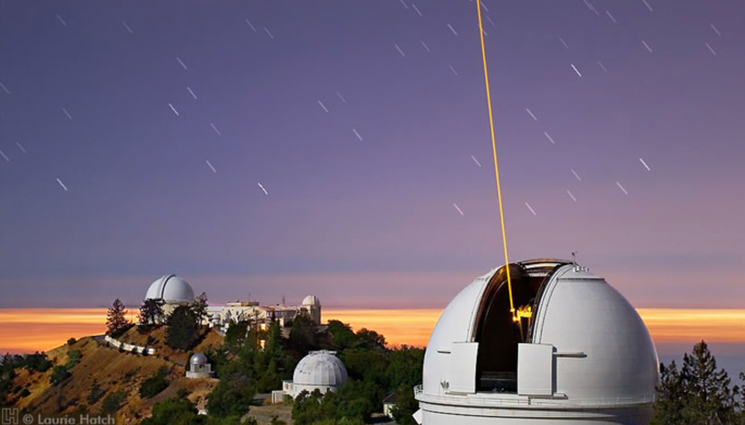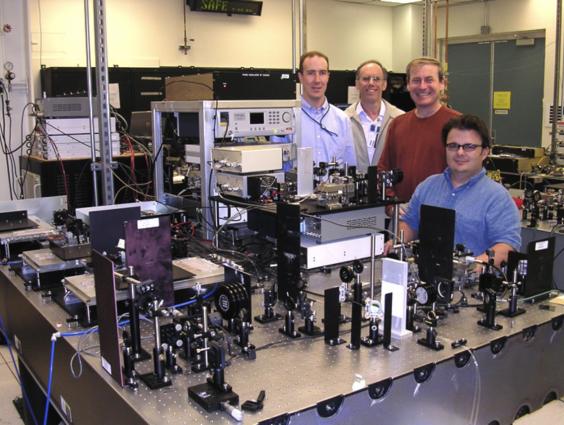Guide star leads to sharper astronomical images
 (Download Image)
The Lick Observatory’s Laser Guide Star forms a beam of glowing atmospheric sodium ions. This helps astronomers account for distortions caused by the Earth’s atmosphere so they can see farther and more clearly into space. Credit: Laurie Hatch/lauriehatch.com
(Download Image)
The Lick Observatory’s Laser Guide Star forms a beam of glowing atmospheric sodium ions. This helps astronomers account for distortions caused by the Earth’s atmosphere so they can see farther and more clearly into space. Credit: Laurie Hatch/lauriehatch.com
The laser guide star revolutionized astronomy by revealing large swaths of the sky that had previously been unseen from Earth due to atmospheric distortions. Now astronomy is on the verge of another great leap forward. The Extremely Large Telescope, which is expected to see first light in 2024, will have a 39-meter-diameter primary mirror — more than three times the size of today’s largest ground-based telescopes.
These next-generation telescopes require even more advanced optics to continue delivering clear images of distant stars, planets and interstellar space. To help answer that call, Lawrence Livermore National Laboratory’s (LLNL) National Ignition Facility and Photon Science (NIF&PS) directorate has delivered a first-of-its-kind, high-power, fiber-based sodium laser guide star to the University of California, Santa Cruz (UCSC).
"This fiber-based sodium laser guide star is a significant advance for adaptive optics," said Daren Dillon, a development engineer at UCSC. "We expect it to operate five to 10 times more efficiently than the state-of-the-art dye-based sodium laser guide stars we use at our observatories now. This will enable our adaptive optics to produce much sharper images."
Adapting fiber laser to a guide star
The project has roots in LLNL’s long history of laser development. Claire Max, a UCSC astronomy professor and director of UC observatories, was a physicist at LLNL from 1974 to 2004. She co-authored the original paper proposing sodium guide star lasers for wavefront correction. In the early 1990s, she demonstrated the first high-power sodium laser guide star from technology developed in LLNL’s Atomic Vapor Laser Isotope Separation program. Max was the driving force for integrating sodium guide star laser systems into the astronomical community worldwide.
To the naked eye, stars appear to twinkle. This is not through any action on the part of the celestial objects, but rather due to atmospheric turbulence — the turbulent mixing of Earth’s atmosphere — that the light rays pass through on their long journey to the eyes of night watchers.
The sodium laser guide star creates an artificial star by shooting a laser into the sodium layer of the atmosphere, about 90 kilometers up. At a wavelength of 589 nanometers (billionths of a meter), the laser excites the sodium, which fluoresces in return. An artificial star is born.
This star provides a reference point for an advanced optics system, which uses it to inform a computer-controlled deformable mirror that cancels out the effects of atmospheric turbulence to create a sharp image.
The first generation of sodium laser guide stars, deployed at the Lick Observatory in Northern California and the Keck Observatory in Hawaii, were dye lasers that served the astronomy community for more than 15 years. Their size, weight and power and cooling requirements, however, made them difficult to incorporate with the telescopes, and they utilized flammable materials, which also are undesirable in an observatory setting.
About 15 years ago, Max made a request of her LLNL colleagues.
Efficient, compact and rugged
"She asked us for a solid-state guide star laser that was compact and reliable," explained Dee Pennington, one of the principal investigators on the project. "We considered several options and settled on a fiber laser because they are efficient, compact and rugged."
A fiber laser typically is constructed with an optical fiber doped with rare-earth elements such as erbium, ytterbium and neodymium. These lasers have unmatched beam quality, efficiency, thermal management and reliability as well as lower cost of ownership.
The project was first funded by Livermore’s Laboratory Directed Research and Development program and later by grants from the National Science Foundation Center for Adaptive Optics, which Max directed, the Association of Universities for Research in Astronomy and the European Southern Observatory.
At the project’s inception more than 15 years ago, fiber lasers were still an emerging technology. None existed at the 589-nanometer (nm) wavelength needed to interrogate the sodium layer.
Developing this fiber laser with UCSC meant the researchers had to invent technology. "We had to learn how to cool a fiber laser," said LLNL materials scientist Steve Payne, another researcher on the project. "If you’re first out of the box, you have to figure everything out on your own."
The team achieved 589 nm by combining a 938-nm laser and a 1,583-nm laser within a nonlinear crystal. Power scaling proved to be an even bigger challenge.
"We were trying to scale two lasers to provide 10 watts of power, the minimum necessary to get enough feedback to inform adaptive optics," said Jay Dawson, the principal investigator in the later years of this project. Dawson has continued working on fiber laser technology in his current role as the NIF&PS acting deputy program director for DoD Technologies.
Because of the laser’s specialized application, custom optical fibers needed to be developed. LLNL did this in collaboration with existing specialty optical fiber companies.
A new fabrication capability
"However, industry was slow to manufacture the fiber we needed," Dawson said. "They had little motivation, since few R&D fibers turn into significant commercial sales. We realized that if we wanted to advance fiber laser technology for a wide array of applications, LLNL would need its own fabrication capability."
As a result, LLNL built its own 8.2-meter fiber draw tower to fabricate the needed specialized fibers. In addition to meeting this need, the draw tower has been the key to success on other important projects. It enabled development of fiber-optic acoustic sensing fibers and the E-band fiber-optic amplifier, two technologies that are revolutionizing laser sensing and communication.
Since commissioning the fiber draw tower, LLNL has applied NIF optics cleaning techniques to microstructured optical fibers to improve strength, loss and reliability. LLNL also has developed consolidation and grinding processes to further open the design space for new optical fibers.
To correct ground-based telescopes with primary mirrors in the 30-meter-diameter range, laser guide stars will be essential. "However, a single guide star laser only can interrogate part of the telescope aperture," Pennington said. "With the huge apertures we anticipate, it will take multiple guide stars to inform adaptive optics for everything the telescope collects." But discriminating the feedback from each individual beam creates a challenge.
"One answer is to use pulsed laser guide stars, which allows discrimination by time," Pennington said. This was the focus of the LLNL fiber guide star laser program.
Next stop, Lick Observatory
UCSC astronomers plan to install the fiber-based sodium laser guide star at the Lick Observatory in the spring of 2019. It will be run alongside the existing dye-based sodium laser guide star.
"We are pretty excited to see what happens when we integrate this fiber-based sodium laser guide star into our adaptive optics system at Lick," Dillon said. "We think it will produce more detailed images that allow more precise measurements."
This technology transfer to UCSC has been a long time in the making. That journey also reflects the advances in fiber laser technology. "As a community, the progress we’ve made is amazing," Pennington said.
-Patricia Koning
Contact
 Breanna Bishop
Breanna Bishop
[email protected]
(925) 423-9802
Related Links
National Ignition Facility and Photon ScienceCenter for Adaptive Optics
the Association of Universities for Research in Astronomy
E-band fiber-optic amplifier
Tags
Lasers and Optical S&TLasers
National Ignition Facility and Photon Science
Physical and Life Sciences
Featured Articles








